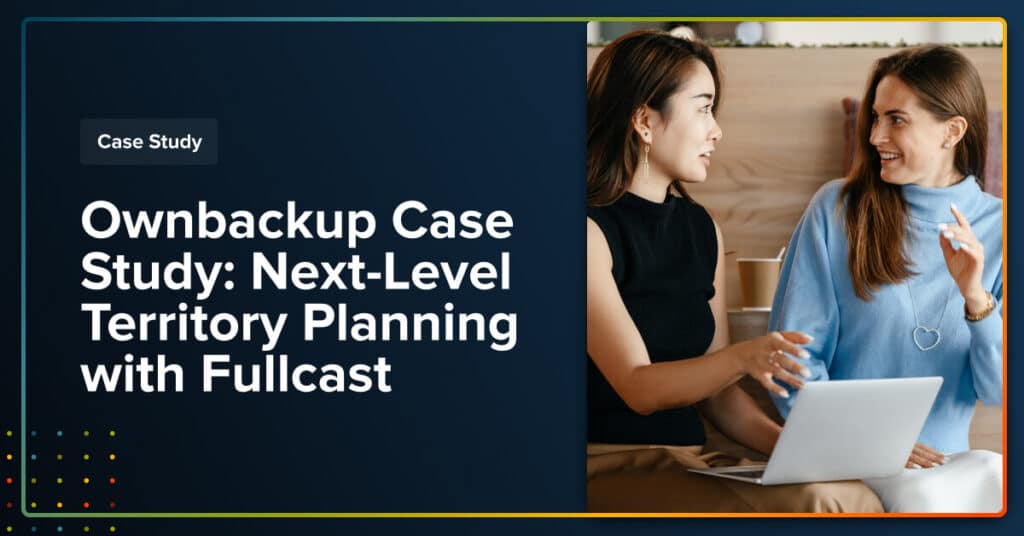FULLCAST VS SALESFORCE ETM
FULLCAST VS SALESFORCE ETM
Fullcast is purpose-built to improve RevOps efficiency and Sales productivity. The platform enables you to design fair, equitable, and transparent territories that keep sellers motivated and on-target, even if resources or your strategy are constantly changing. No spreadsheets or custom code are ever required.
Top 5 Reasons to Choose Fullcast over Salesforce ETM
Assign the Right Sales Resources to the Right Accounts
With Fullcast, balance your territories using the metrics that matter most to your business – without a single spreadsheet. Carve your territories and get instant feedback on equitability. Or let SmartPlan, our AI-powered territory balancer, do the hard work for you, 10-20x faster.
With ETM, balancing is done in spreadsheets and then the final rules are manually entered into Salesforce.




Make Smarter Business Decisions
Easily model different scenarios and instantly see metrics on the current state, the proposed state, and the/impact of the proposed changes by any metric – not just accounts.
ETM offers some modeling capabilities, however, only the ability to see the impact on the number of accounts, not the financial impact of any changes.
Manage Multiple GTM Models with Ease
If upsell and expansion deals are a priority your Customer Success team needs its own GTM model. With Fullcast, you can build multiple active territory models to support different GTM plans, such as different Sales, Market Development, or Customer Success.
ETM, on the other hand, allows only one model to be active at a time, making it difficult to tackle anything beyond new business opportunities.




Assign Accounts with Flexibility
Go beyond simple straightforward territory account assignments and create assignment models that work best for your business – round robin, weighted round robin, skills-based, role based, or any type of multi-layered approach.
Manage Multiple GTM Models with Ease
If upsell and expansion deals are a priority your Customer Success team needs its own GTM model. With Fullcast, you can build multiple active territory models to support different GTM plans, such as different Sales, Market Development, or Customer Success.
ETM, on the other hand, allows only one model to be active at a time, making it difficult to tackle anything beyond new business opportunities.


Fullcast vs Salesforce ETM
Territory Management
Fullcast
Salesforce ETM
Spreadsheet-free territory balancing
Real-time feedback on territory balancing using metrics
Ability to run rules and see immediate feedback on which accounts are in each territory
Automated Territory Optimizer (SmartPlan)
“Click and build” geographic territory mapping with map visualization
Ability to create field-based rules for assigning accounts to territories (including AND/OR scenarios)
Support for Named Accounts, including Named Exceptions
Support for Account Families
Ability to run multiple territory models simultaneously (e.g., Sales plan, CS plan)
What-If Analysis, including ability to see impact based on any metric, not just number of accounts (e.g., financial metrics)
Ability for field managers to make self-service plan changes directly in the CRM
Reporting by territory
Coverage Assignments
Role-based assignments (e.g, assign prospects to SDRs and accounts to Account Managers).
Round-robin based assignments, including weighted round robin.
Capacity tracking, such as temporary coverage, new hires, transfers, and tracking of ramping resources
Effective dating of roles and their association to territories for crediting accuracy
Coverage Assignments
Ability to make run-time plan changes and deploy instantly to your CRM
Ability to set and automate routing to stay in alignment with your territory plan
Ability to set and automate holdout rules
Ability to set and automate data hygiene rules (e.g., deduping, compliance, industry taxonomy)
Quota/Target Planning
Tops-down and bottoms-up quota or target planning in relation to territory or team organization.
Automated quota and territory sync (e.g., if accounts are changed, quota and targets are automatically updated.)
Ability to track attainment against targets in multiple hierarchies.

Work with the Applications You Already Use
Fullcast boasts a robust set of integrations that connect to the apps your team is already using, so the work you’re doing with Fullcast can easily inform activities performed in other pieces of your RevOps tech stack.

















